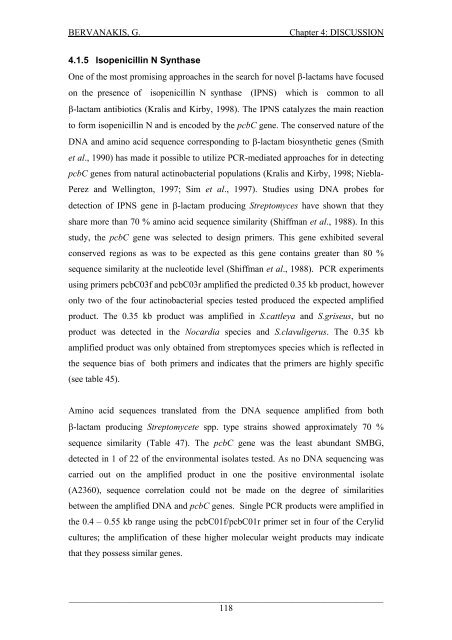Detection and Expression of Biosynthetic Genes in Actinobacteria ...
Detection and Expression of Biosynthetic Genes in Actinobacteria ...
Detection and Expression of Biosynthetic Genes in Actinobacteria ...
You also want an ePaper? Increase the reach of your titles
YUMPU automatically turns print PDFs into web optimized ePapers that Google loves.
BERVANAKIS, G.Chapter 4: DISCUSSION4.1.5 Isopenicill<strong>in</strong> N SynthaseOne <strong>of</strong> the most promis<strong>in</strong>g approaches <strong>in</strong> the search for novel β-lactams have focusedon the presence <strong>of</strong> isopenicill<strong>in</strong> N synthase (IPNS) which is common to allβ-lactam antibiotics (Kralis <strong>and</strong> Kirby, 1998). The IPNS catalyzes the ma<strong>in</strong> reactionto form isopenicill<strong>in</strong> N <strong>and</strong> is encoded by the pcbC gene. The conserved nature <strong>of</strong> theDNA <strong>and</strong> am<strong>in</strong>o acid sequence correspond<strong>in</strong>g to β-lactam biosynthetic genes (Smithet al., 1990) has made it possible to utilize PCR-mediated approaches for <strong>in</strong> detect<strong>in</strong>gpcbC genes from natural act<strong>in</strong>obacterial populations (Kralis <strong>and</strong> Kirby, 1998; Niebla-Perez <strong>and</strong> Well<strong>in</strong>gton, 1997; Sim et al., 1997). Studies us<strong>in</strong>g DNA probes fordetection <strong>of</strong> IPNS gene <strong>in</strong> β-lactam produc<strong>in</strong>g Streptomyces have shown that theyshare more than 70 % am<strong>in</strong>o acid sequence similarity (Shiffman et al., 1988). In thisstudy, the pcbC gene was selected to design primers. This gene exhibited severalconserved regions as was to be expected as this gene conta<strong>in</strong>s greater than 80 %sequence similarity at the nucleotide level (Shiffman et al., 1988). PCR experimentsus<strong>in</strong>g primers pcbC03f <strong>and</strong> pcbC03r amplified the predicted 0.35 kb product, howeveronly two <strong>of</strong> the four act<strong>in</strong>obacterial species tested produced the expected amplifiedproduct. The 0.35 kb product was amplified <strong>in</strong> S.cattleya <strong>and</strong> S.griseus, but noproduct was detected <strong>in</strong> the Nocardia species <strong>and</strong> S.clavuligerus. The 0.35 kbamplified product was only obta<strong>in</strong>ed from streptomyces species which is reflected <strong>in</strong>the sequence bias <strong>of</strong> both primers <strong>and</strong> <strong>in</strong>dicates that the primers are highly specific(see table 45).Am<strong>in</strong>o acid sequences translated from the DNA sequence amplified from bothβ-lactam produc<strong>in</strong>g Streptomycete spp. type stra<strong>in</strong>s showed approximately 70 %sequence similarity (Table 47). The pcbC gene was the least abundant SMBG,detected <strong>in</strong> 1 <strong>of</strong> 22 <strong>of</strong> the environmental isolates tested. As no DNA sequenc<strong>in</strong>g wascarried out on the amplified product <strong>in</strong> one the positive environmental isolate(A2360), sequence correlation could not be made on the degree <strong>of</strong> similaritiesbetween the amplified DNA <strong>and</strong> pcbC genes. S<strong>in</strong>gle PCR products were amplified <strong>in</strong>the 0.4 – 0.55 kb range us<strong>in</strong>g the pcbC01f/pcbC01r primer set <strong>in</strong> four <strong>of</strong> the Cerylidcultures; the amplification <strong>of</strong> these higher molecular weight products may <strong>in</strong>dicatethat they possess similar genes._____________________________________________________________________118















